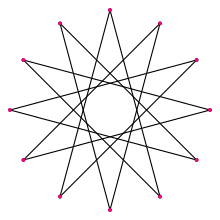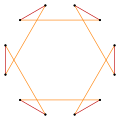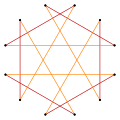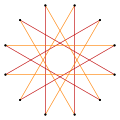

This article needs additional citations for verification. Please help improve this articlebyadding citations to reliable sources. Unsourced material may be challenged and removed.
Find sources: "Dodecagram" – news · newspapers · books · scholar · JSTOR (August 2012) (Learn how and when to remove this message) |
| Regular dodecagram | |
|---|---|

A regular dodecagram
| |
| Type | Regular star polygon |
| Edges and vertices | 12 |
| Schläfli symbol | {12/5} t{6/5} |
| Coxeter–Dynkin diagrams | |
| Symmetry group | Dihedral (D12) |
| Internal angle (degrees) | 30° |
| Properties | star, cyclic, equilateral, isogonal, isotoxal |
| Dual polygon | self |
| Star polygons |
|---|
|
|
|
|
|
|
Ingeometry, a dodecagram (from Greek δώδεκα (dṓdeka) 'twelve', and γραμμῆς (grammēs) 'line'[1]) is a star polygon or compound with 12 vertices. There is one regular dodecagram polygon (with Schläfli symbol {12/5} and a turning number of 5). There are also 4 regular compounds {12/2}, {12/3}, {12/4}, and {12/6}.
There is one regular form: {12/5}, containing 12 vertices, with a turning number of 5. A regular dodecagram has the same vertex arrangement as a regular dodecagon, which may be regarded as {12/1}.
There are four regular dodecagram star figures: {12/2}=2{6}, {12/3}=3{4}, {12/4}=4{3}, and {12/6}=6{2}. The first is a compound of two hexagons, the second is a compound of three squares, the third is a compound of four triangles, and the fourth is a compound of six straight-sided digons. The last two can be considered compounds of two compound hexagrams and the last as three compound tetragrams.
Anisotoxal polygon has two vertices and one edge type within its symmetry class. There are 5 isotoxal dodecagram star with a degree of freedom of angles, which alternates vertices at two radii, one simple, 3 compounds, and 1 unicursal star.
| Type | Simple | Compounds | Star | ||
|---|---|---|---|---|---|
| Density | 1 | 2 | 3 | 4 | 5 |
| Image |  {(6)α} |
 2{3α} |
 3{2α} |
 2{(3/2)α} |
 {(6/5)α} |
A regular dodecagram can be seen as a quasitruncated hexagon, t{6/5}={12/5}. Other isogonal (vertex-transitive) variations with equally spaced vertices can be constructed with two edge lengths.
 t{6} |

|

|
 t{6/5}={12/5} |
Superimposing all the dodecagons and dodecagrams on each other – including the degenerate compound of six digons (line segments), {12/6} – produces the complete graph K12.
Dodecagrams can also be incorporated into uniform polyhedra. Below are the three prismatic uniform polyhedra containing regular dodecagrams (there are no other dodecagram-containing uniform polyhedra).
Dodecagrams can also be incorporated into star tessellations of the Euclidean plane.

Dodecagrams or twelve-pointed stars have been used as symbols for the following:
|
| |||||||
|---|---|---|---|---|---|---|---|
| Triangles |
| ||||||
| Quadrilaterals |
| ||||||
| By number of sides |
| ||||||
| Star polygons |
| ||||||
| Classes |
| ||||||